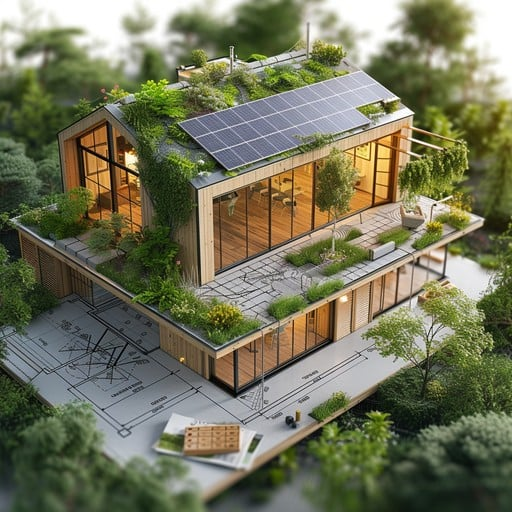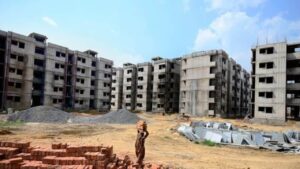The urban world is evolving. With environmental degradation, resource scarcity, and rising energy demands becoming a global concern, there’s a major shift toward sustainable lifestyles, and at the core of this transition lies green housing. These aren’t just homes; they’re intelligent, energy-efficient, water-conscious living spaces that integrate modern comfort with nature’s wisdom.
Today, green housing projects in India are picking up momentum, especially in cities like Pune, Bengaluru, Trivandrum, and Kochi. With features like solar roofing systems and rainwater harvesting units, these homes aim to reduce your carbon footprint and running costs while improving your quality of life.
In this detailed guide, let’s explore how these homes function, what makes them unique, and whether you should consider investing in one.
Also Read:- Smart Township Initiatives in Trivandrum and Kochi
What Are Green Housing Projects and Why Are They Important?

Green housing refers to environmentally conscious residential projects that promote energy and water conservation while minimizing waste and pollution. The construction materials, architectural layout, water systems, lighting, ventilation, and landscaping are all carefully curated to support sustainable living.
Why It Matters:
- Reduces greenhouse gas emissions
- Conserves natural resources
- Reduces electricity and water bills
- Enhances indoor air quality
- Improves overall quality of life
- Offers long-term financial savings
Also Read:- Ujjain Smart City in Madya Pradesh 2025 – Housiey
How Does Solar Roofing Contribute to Sustainable Housing?
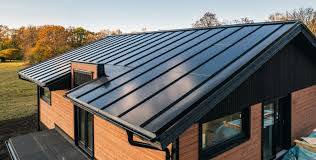
One of the biggest advantages of green homes is the use of solar roofing. Instead of drawing electricity from conventional power grids (often generated by fossil fuels), these homes generate their own electricity using solar panels installed on rooftops.
How It Works:
- Solar panels absorb sunlight and convert it into direct current (DC).
- An inverter changes DC to alternating current (AC), which powers your home.
- In some cases, a battery system stores excess power for later use.
- If the home is connected to the grid, surplus energy can be sent back through net metering, earning credit from the electricity provider.
Solar Roofing Advantages:
- Significant reduction in monthly power bills
- Decreased reliance on non-renewable resources
- Increases overall property value
- Easy integration with home automation systems
Also Read:- Next-Gen Living Exploring Smart Home & PropTech Innovations
What Role Does Rainwater Harvesting Play in Green Housing?
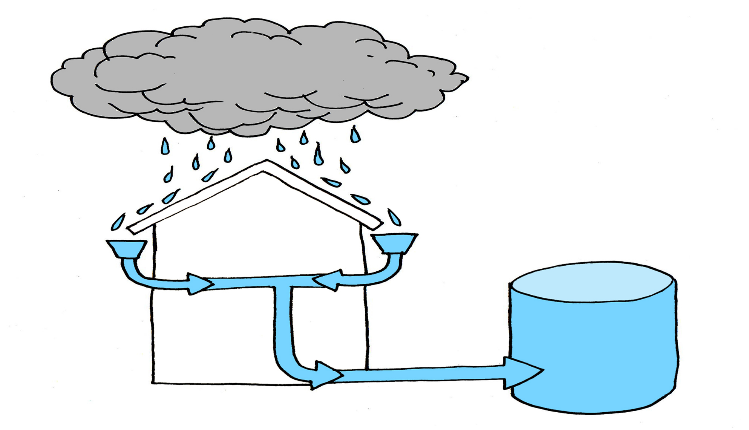
Rainwater harvesting (RWH) is a time-tested technique of collecting and storing rainwater from rooftops and other surfaces for later use. In green housing projects, RWH is seamlessly integrated into the home’s water infrastructure.
Rainwater Harvesting Key Components:
- Catchment Area: Typically, the rooftop
- Gutters and Downpipes: Direct rainwater to the filtration system
- First Flush Device: Diverts initial dirty runoff
- Filter Unit: Removes debris and pollutants
- Storage Tank or Recharge Pit: Holds the clean water or sends it into the ground
What are the Uses of Rainwater Harvesting?
- Gardening and irrigation
- Car washing and floor cleaning
- Toilet flushing
- With treatment, it can be used for drinking as well
Rainwater Harvesting Advantages:
- Reduces dependency on municipal water supply
- Helps recharge local groundwater levels
- Prevents waterlogging and surface runoff
- Especially beneficial in drought-prone areas
Also Read:- Vertical Housing for EWS under PPP Model.
What Other Features Define a Green Housing Project?
Green homes go beyond solar and water-saving solutions. Here’s what else they typically include:
- LED lighting and motion-sensor lights
- Low-flow plumbing fixtures to minimize water usage
- Recycled or locally sourced building materials
- Green roofs and vertical gardens
- Natural ventilation and daylighting design
- Waste segregation and composting systems
- Eco-friendly paints and finishes with low VOC levels
These features not only reduce energy use but also promote healthier indoor environments and lower operating costs.
Are Green Homes Expensive to Build or Buy?
The perception that green homes are too expensive is gradually changing. While the upfront cost may be slightly higher—typically around 5-10% more than conventional homes—the long-term benefits far outweigh this difference.
Long-Term Benefits:
- Reduction in utility bills by 30–50%
- Less maintenance over the years
- Improved health and productivity of occupants
- Higher resale value
Government Incentives:
- Subsidies for solar panel installation
- Rebates on property taxes in certain cities
- Low-interest loans for green home upgrades
Also Read:- All You Need to Know About Vastu Shashtra
Which Indian Cities Are Leading the Way in Green Housing?
India is witnessing a wave of eco-conscious real estate, with several cities spearheading the movement.
Popular Cities:
- Bengaluru: Abundance of sunshine, leading to solar-centric housing
- Pune: New-age developers offering green-certified townships
- Mumbai: Premium housing integrates solar, RWH, and air-purifying landscapes
- Trivandrum and Kochi: Strong municipal push toward smart and green housing
- Chennai: Heavy focus on water conservation due to recurring droughts
In these cities, green housing is not just about reducing bills—it’s about future-proofing homes for the next generation.
What Are the Challenges of Integrating Solar and RWH Systems?
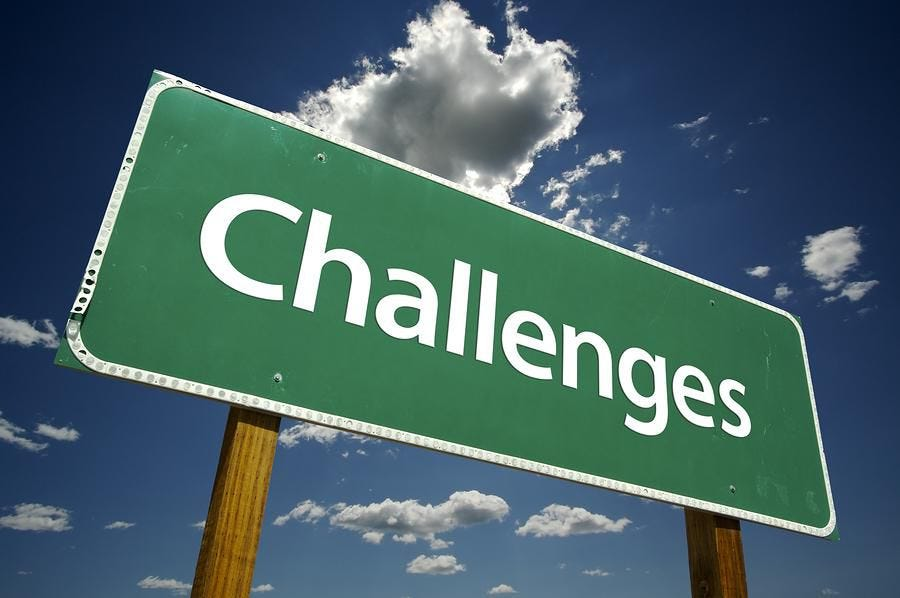
Even though green housing is rapidly gaining traction, it does face certain challenges:
Solar Roofing:
- High upfront investment
- Reduced efficiency during monsoon/cloudy days
- Requires periodic cleaning and servicing
Rainwater Harvesting:
- Needs regular filter cleaning
- Possible risk of contamination if poorly maintained
- It may not be sufficient in low-rainfall areas
However, most developers now include professionally installed and maintained systems to eliminate these concerns from the buyer’s end.
Which Builders Are Pioneering Green Housing in India?
Several reputed builders have embraced sustainable practices and are actively incorporating green elements into their residential offerings.
Notable Developers:
- Mahindra Lifespaces: Known for zero-waste and carbon-neutral projects
- Godrej Properties: Offers IGBC-certified townships and apartments
- Tata Housing: Among the earliest to implement RWH and solar rooftops
- Brigade Group: Sustainable practices in community water and waste management
- Sobha Developers: Integrated rainwater harvesting and energy efficiency in large projects
These developers are not only building homes—they’re creating self-sufficient, eco-friendly ecosystems.
Also Read:- Best Single Floor House Design in 2025
What Certifications Should You Look for in a Green Home?
Buying a green home isn’t just about trusting brochures. Look for certified properties that meet national and international standards.
Common Certifications:
- IGBC (Indian Green Building Council)
- GRIHA (Green Rating for Integrated Habitat Assessment)
- EDGE (Excellence in Design for Greater Efficiencies)
- LEED (Leadership in Energy and Environmental Design)
These certifications assure that the property meets specific sustainability benchmarks in design, energy, water use, and material selection.
What Does the Future Hold for Green Housing?
The future of real estate lies in sustainable practices. As cities become more congested and natural resources become scarcer, green housing will no longer be optional—it’ll be the default.
What We Can Expect:
- AI-based energy management systems
- Smart home integration with solar and RWH systems
- Widespread adoption of electric vehicle charging points
- Community-level solar farms and STPs (Sewage Treatment Plants)
- Increased government regulations to push sustainability
Also Read:- Room Size as per Vastu: Bedroom | Kitchen | Living Room | Pooja Room
Conclusion
The shift toward green housing isn’t just a passing trend—it’s an essential evolution in how we live. With the integration of solar energy and rainwater harvesting, modern homes are becoming self-reliant, energy-efficient, and environmentally responsible. These homes not only lower your carbon footprint but also offer tangible financial benefits.
If you’re a homebuyer seeking long-term value, low utility costs, and a healthier living environment, then a green home is a sound investment. And if you’re unsure where to begin, Housiey Blogs offers you a transparent platform where you can explore green housing options, connect directly with verified builders, and avoid unnecessary broker intervention.
Looking for affordable ways to finance your home? Don’t forget to read our comprehensive blog on “Kerala State Housing Board 2025: Loan Scheme | Contact Number” to discover how you can secure funding for your dream eco-friendly home.
FAQs
The urban world is evolving. With environmental degradation, resource scarcity, and rising energy demands becoming a global concern, there’s a major shift toward sustainable lifestyles, and at the core of this transition lies green housing. These aren’t just homes; they’re intelligent, energy-efficient, water-conscious living spaces that integrate modern comfort with nature’s wisdom.
Today, green housing projects in India are picking up momentum, especially in cities like Pune, Bengaluru, Trivandrum, and Kochi. With features like solar roofing systems and rainwater harvesting units, these homes aim to reduce your carbon footprint and running costs while improving your quality of life.
In this detailed guide, let’s explore how these homes function, what makes them unique, and whether you should consider investing in one.
Also Read:- Smart Township Initiatives in Trivandrum and Kochi
What Are Green Housing Projects and Why Are They Important?

Green housing refers to environmentally conscious residential projects that promote energy and water conservation while minimizing waste and pollution. The construction materials, architectural layout, water systems, lighting, ventilation, and landscaping are all carefully curated to support sustainable living.
Why It Matters:
- Reduces greenhouse gas emissions
- Conserves natural resources
- Reduces electricity and water bills
- Enhances indoor air quality
- Improves overall quality of life
- Offers long-term financial savings
Also Read:- Ujjain Smart City in Madya Pradesh 2025 – Housiey
How Does Solar Roofing Contribute to Sustainable Housing?

One of the biggest advantages of green homes is the use of solar roofing. Instead of drawing electricity from conventional power grids (often generated by fossil fuels), these homes generate their own electricity using solar panels installed on rooftops.
How It Works:
- Solar panels absorb sunlight and convert it into direct current (DC).
- An inverter changes DC to alternating current (AC), which powers your home.
- In some cases, a battery system stores excess power for later use.
- If the home is connected to the grid, surplus energy can be sent back through net metering, earning credit from the electricity provider.
Solar Roofing Advantages:
- Significant reduction in monthly power bills
- Decreased reliance on non-renewable resources
- Increases overall property value
- Easy integration with home automation systems
Also Read:- Next-Gen Living Exploring Smart Home & PropTech Innovations
What Role Does Rainwater Harvesting Play in Green Housing?

Rainwater harvesting (RWH) is a time-tested technique of collecting and storing rainwater from rooftops and other surfaces for later use. In green housing projects, RWH is seamlessly integrated into the home’s water infrastructure.
Rainwater Harvesting Key Components:
- Catchment Area: Typically, the rooftop
- Gutters and Downpipes: Direct rainwater to the filtration system
- First Flush Device: Diverts initial dirty runoff
- Filter Unit: Removes debris and pollutants
- Storage Tank or Recharge Pit: Holds the clean water or sends it into the ground
What are the Uses of Rainwater Harvesting?
- Gardening and irrigation
- Car washing and floor cleaning
- Toilet flushing
- With treatment, it can be used for drinking as well
Rainwater Harvesting Advantages:
- Reduces dependency on municipal water supply
- Helps recharge local groundwater levels
- Prevents waterlogging and surface runoff
- Especially beneficial in drought-prone areas
Also Read:- Vertical Housing for EWS under PPP Model.
What Other Features Define a Green Housing Project?
Green homes go beyond solar and water-saving solutions. Here’s what else they typically include:
- LED lighting and motion-sensor lights
- Low-flow plumbing fixtures to minimize water usage
- Recycled or locally sourced building materials
- Green roofs and vertical gardens
- Natural ventilation and daylighting design
- Waste segregation and composting systems
- Eco-friendly paints and finishes with low VOC levels
These features not only reduce energy use but also promote healthier indoor environments and lower operating costs.
Are Green Homes Expensive to Build or Buy?
The perception that green homes are too expensive is gradually changing. While the upfront cost may be slightly higher—typically around 5-10% more than conventional homes—the long-term benefits far outweigh this difference.
Long-Term Benefits:
- Reduction in utility bills by 30–50%
- Less maintenance over the years
- Improved health and productivity of occupants
- Higher resale value
Government Incentives:
- Subsidies for solar panel installation
- Rebates on property taxes in certain cities
- Low-interest loans for green home upgrades
Also Read:- All You Need to Know About Vastu Shashtra
Which Indian Cities Are Leading the Way in Green Housing?
India is witnessing a wave of eco-conscious real estate, with several cities spearheading the movement.
Popular Cities:
- Bengaluru: Abundance of sunshine, leading to solar-centric housing
- Pune: New-age developers offering green-certified townships
- Mumbai: Premium housing integrates solar, RWH, and air-purifying landscapes
- Trivandrum and Kochi: Strong municipal push toward smart and green housing
- Chennai: Heavy focus on water conservation due to recurring droughts
In these cities, green housing is not just about reducing bills—it’s about future-proofing homes for the next generation.
What Are the Challenges of Integrating Solar and RWH Systems?

Even though green housing is rapidly gaining traction, it does face certain challenges:
Solar Roofing:
- High upfront investment
- Reduced efficiency during monsoon/cloudy days
- Requires periodic cleaning and servicing
Rainwater Harvesting:
- Needs regular filter cleaning
- Possible risk of contamination if poorly maintained
- It may not be sufficient in low-rainfall areas
However, most developers now include professionally installed and maintained systems to eliminate these concerns from the buyer’s end.
Which Builders Are Pioneering Green Housing in India?
Several reputed builders have embraced sustainable practices and are actively incorporating green elements into their residential offerings.
Notable Developers:
- Mahindra Lifespaces: Known for zero-waste and carbon-neutral projects
- Godrej Properties: Offers IGBC-certified townships and apartments
- Tata Housing: Among the earliest to implement RWH and solar rooftops
- Brigade Group: Sustainable practices in community water and waste management
- Sobha Developers: Integrated rainwater harvesting and energy efficiency in large projects
These developers are not only building homes—they’re creating self-sufficient, eco-friendly ecosystems.
Also Read:- Best Single Floor House Design in 2025
What Certifications Should You Look for in a Green Home?
Buying a green home isn’t just about trusting brochures. Look for certified properties that meet national and international standards.
Common Certifications:
- IGBC (Indian Green Building Council)
- GRIHA (Green Rating for Integrated Habitat Assessment)
- EDGE (Excellence in Design for Greater Efficiencies)
- LEED (Leadership in Energy and Environmental Design)
These certifications assure that the property meets specific sustainability benchmarks in design, energy, water use, and material selection.
What Does the Future Hold for Green Housing?
The future of real estate lies in sustainable practices. As cities become more congested and natural resources become scarcer, green housing will no longer be optional—it’ll be the default.
What We Can Expect:
- AI-based energy management systems
- Smart home integration with solar and RWH systems
- Widespread adoption of electric vehicle charging points
- Community-level solar farms and STPs (Sewage Treatment Plants)
- Increased government regulations to push sustainability
Also Read:- Room Size as per Vastu: Bedroom | Kitchen | Living Room | Pooja Room
Conclusion
The shift toward green housing isn’t just a passing trend—it’s an essential evolution in how we live. With the integration of solar energy and rainwater harvesting, modern homes are becoming self-reliant, energy-efficient, and environmentally responsible. These homes not only lower your carbon footprint but also offer tangible financial benefits.
If you’re a homebuyer seeking long-term value, low utility costs, and a healthier living environment, then a green home is a sound investment. And if you’re unsure where to begin, Housiey Blogs offers you a transparent platform where you can explore green housing options, connect directly with verified builders, and avoid unnecessary broker intervention.
Looking for affordable ways to finance your home? Don’t forget to read our comprehensive blog on “Kerala State Housing Board 2025: Loan Scheme | Contact Number” to discover how you can secure funding for your dream eco-friendly home.
FAQs





